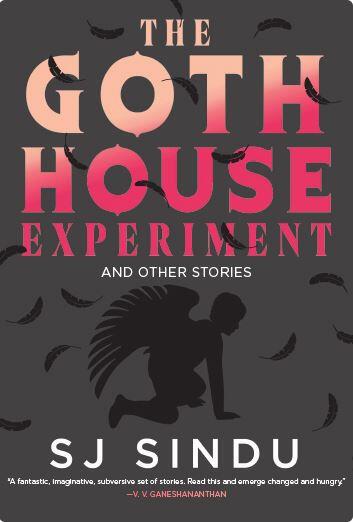
Oct. 31, 2023
VCU author SJ Sindu explores isolation and artistry in short story collection ‘The Goth House Experiment’
Share this story
After an almost 12-year writing process, Virginia Commonwealth University creative writing professor SJ Sindu has completed “The Goth House Experiment,” a collection of short stories that explores the search for connections in an increasingly isolated world.
Sindu teaches in VCU’s MFA in Creative Writing program and has published several books, including the recent middle-grade graphic novel “Shakti.” Sindu spoke with VCU News about “The Goth House Experiment,” writing short stories, the duplicity of online communities and how their reality can become their writing.
How does “The Goth House Experiment” differ from your previous books?
I’ve been writing short stories for a very long time, but I don’t really consider myself a short-story writer. It’s not my primary medium, it’s not my primary form. So, it actually takes me a very long time to write a short story. I work on a single short story for months or years, so this represents about 12 years of work.
What connects the short stories in the collection?
All of my main characters tend to be outsiders in some way. They are loners, they’re artists, they have some level of identity or some combination of identities that sets them apart and makes them outside observers for the world. I think that’s a very useful perspective to use, especially when you’re writing mostly realist fiction. All of these stories live somewhere between real and the surreal. There’s no, like, capital-M magic, but reality is heightened in most of these stories — just a little bit turned up. It’s a little bit technicolor sometimes, and then it steadily progresses toward a much more surrealist, fabulous thing.
I’m also really interested in this sense of isolation we feel as we get increasingly connected to each other. It’s really fascinating to me that the more globally connected we get and the more connected we get on social media, the more isolated and lonely people have felt. It’s really interesting because, ostensibly, we go to social media for community. But instead of finding a loving community, often we find the opposite, and we find community that polices us or that is toxic in some ways or that gossips or that attacks us. I’m also really interested in the ways there’s infighting within communities.
There’s also a thread of what it means to be an artist and what it means to make art, and what it means to be an intellectual in today’s society. I’m talking about things like cancel culture, things like online harassment and doxxing.
Which story in the collection feels most personal to you?

The first one, “Dark Academica and the Lesbian Masterdoc.” It’s really the only one where it’s a combination of real things that have happened to me at different moments in my time, as an academic and as a writer and just as a person living in the world. I took those different moments and combined them together and increased the pressure in a way that builds to this breaking point. Once it starts to build to that breaking point (that’s fictional), but everything else — pretty much — is true. Maybe not with a capital T, but with a small T.
I had TikTok for about a month and I went viral. I was harassed – all of the online harassment in the story is verbatim from stuff that people have said to me – and I promptly deleted it before it got to the point where I’d get doxxed or something, which was my fear. In the story, of course, she does get doxxed. I step back from the edge in my real life, but in my fiction I allow myself to push my character to the edge and sometimes off of it.
Was that a difficult process, to look at what happened to you and write about it?
It was very cathartic to do. I needed to write about it. I needed to put it down on paper because it was just such a bizarre thing. When it happens, it feels so isolating because there’s not that many people that you can talk about it with that are not online, and to be online feels scary. It’s a weird thing to navigate.
What are the biggest challenges of writing short stories?
A short story can’t hold very much. It can hold an incredibly big amount, but it can’t hold more than two story arcs. It can’t hold more than a handful of characters. It can’t really hold more than a certain number of events and a certain number of scenes. In a novel, you have a lot of time to explore characters and build the world and let the reader sink into the experience before you start the story, before you start things moving. In a short story, you don’t have that luxury. You have to build the world, make the reader feel grounded in the world and as if they know the character very well, within one or two pages, if that. That’s difficult.
Because of the shortened, condensed feeling of a short story and the short page space, you have to do things very quickly and you have to do things very efficiently. You have to develop characters and give them flaws and complexity very efficiently, whereas you would have a lot of time to do that in a novel.
Every word counts in a short story — at least, how I approach the short story. I want it to sing on a sentence level, and I want to make sure every single sentence is strong. In an 85,000-word novel, that’s not necessarily easy or possible, even. But in a short story that’s 5,000 words or 6,000 words, that’s totally possible.
What does the title mean?
“Goth House Experiment” is one of the short stories that’s in the collection. The short story that it’s named after is about a young poet named Dave who inherits this gothic mansion from his mother, who has died of cancer. He decides to live there and be a writer, and the mansion is haunted by the ghost of Oscar Wilde. He’s moving through, trying to write his poems, and Oscar Wilde is haunting him in that he’s following him around and telling him he will never be the kind of writer he wants to be.
It’s a story about grief, but it’s also a story about art and what it means to be an artist and what it means to yearn for that. And, to also have this voice of the critic in your head. That voice that tells you you’ll never be good enough, the voice that makes you feel like an imposter — that is personified by the ghost of Oscar Wilde.
It’s my favorite story in the collection. It was really, really fun to write. I thought it also captured some of what I’m trying to do with this book in general, which is that all these stories are wildly different and I’m putting them together because they are not the same in terms of content but they are the same in terms of deep, thematic links.
Any new projects we can look forward to?
Next year, my second graphic novel is coming out. It’s called “Tall Water.” It’s about a young girl who goes back to Sri Lanka to find her birth mother, only to get caught up in the 2004 tsunami and the aftermath.
Subscribe to VCU News
Subscribe to VCU News at newsletter.vcu.edu and receive a selection of stories, videos, photos, news clips and event listings in your inbox.







